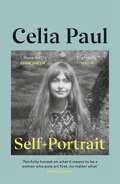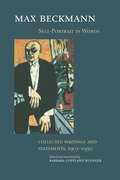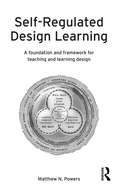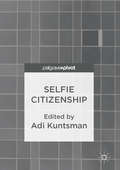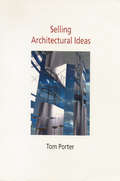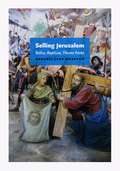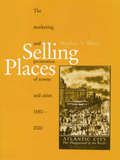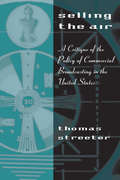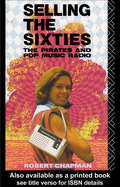- Table View
- List View
Self-Made: Creating Our Identities from Da Vinci to the Kardashians
by Tara Isabella Burton'We're all now self-makers, whether we like it or not - and this witty, sceptical book is the thought-provoking story of how we got here' GUARDIAN'This funny, startling, insightful story of the selfie, from Dürer to the Kardashians, is a must read if you want to understand how we reinvent ourselves every time we reveal ourselves' PETER POMERANTSEVToday's defining celebrities have crafted public personae that walk the tightrope between authenticity and artificiality. Ordinary people now follow suit: lovingly tending our 'personal brands' for economic gain and self-expression alike.Instagram culture is part of a story that goes back centuries. The vision that we not only can but should 'make' our own selves to shape our own destiny is an inextricable part of the formation of the modern world.As traditional powers of pre-modernity - church and throne - waned, a new myth took their place: that of the 'self-made man', whose unique powers of personality - or canny self-presentation - give him not just the opportunity, but the obligation, to remake reality in the image of what he wants it to be.From the Renaissance genius to the Regency dandy, the American prophets of capitalism to the aspirational übermensch of European fascism, Hollywood's Golden Age to today's Silicon Valley, Self-Made takes us on a dazzling tour of modern history's most prominent self-makers, uncovering both self-making's liberatory power, and the dangers this idea can unleash.'Both revelatory and a warning about the ways that focus on the self distorts our individual lives and the broader society' FRANCIS FUKUYAMA
Self-Portrait
by Celia PaulI’m not a portrait painter. If I’m anything, I have always been an autobiographer.Self-Portrait reveals a life truly lived through art. In this short, intimate memoir, Celia Paul moves effortlessly through time in words and images, folding in her past and present selves. From her move to the Slade School of Fine Art at sixteen, through a profound and intense affair with the older and better-known artist Lucian Freud, to the practices of her present-day studio, she meticulously assembles the surprising, beautiful, haunting scenes of a life. Paul brings to her prose the same qualities that she brings to her art: a brutal honesty, a delicate but powerful intensity, and an acute eye for visual detail. At its heart, this is a book about a young woman becoming an artist, with all the sacrifices and complications that entails. As she moves out of Freud’s shadow, and navigates a path to artistic freedom, Paul’s power and identity as an artist emerge from the page. Self-Portrait is a uniquely arresting, poignant book, and a work of art and literature by a singular talent.
Self-Portrait in Words: Collected Writings and Statements, 1903-1950
by Max BeckmannOne of the most important German artists of the twentieth century, Max Beckmann is known for the depth and sensuous force of his works, but little is known about his personal life. Self-Portrait in Words reveals Beckmann's experience of life from the first years of his career in Berlin and Paris through his final years in the United States. This collection of Beckmann's writings serves as a companion to his art and a testament to the complexities of his life. "Barbara Copeland Buenger . . . has done an excellent job of editing and annotating Beckmann's voluminous private and public writings."—Andrea Barnet, New York Times Book Review
Self-Regulated Design Learning: A Foundation and Framework for Teaching and Learning Design
by Matthew N. PowersSelf-Regulated Design Learning: A Foundation and Framework for Teaching and Learning Design reframes how educators in architecture, landscape architecture, and other design disciplines think about teaching and learning design. The book weaves together concepts of constructivism, social cognitive theory, and self-regulated learning into a solid theoretical foundation for innovative teaching that emphasizes meaning, memory, problem solving, and mastery. The central goal of self-regulated design learning is making design learnable so that students are encouraged to become active, engaged participants in the design learning process. Key features of the book include: examining the issues, values, and challenges of teaching and learning in design, exploring select educational theories and concepts relevant to design pedagogy, illustrating the pivotal relationships between design learning and self-regulation, and discussing pedagogic techniques that support self-regulated design learning and lead to greater student achievement and performance. Self-Regulated Design Learning: A Foundation and Framework for Teaching and Learning Design provides numerous examples and applications to help design educators understand how to implement the self-regulated design learning methodology in their studios. Through this book, design educators will discover new ways of encouraging meaningful design learning through an advanced approach that is empowering, inspiring, and vital.
Self-Regulated Design Learning: A Foundation and Framework for Teaching and Learning Design
by Matthew N. PowersSelf-Regulated Design Learning: A Foundation and Framework for Teaching and Learning Design reframes how educators in architecture, landscape architecture, and other design disciplines think about teaching and learning design. The book weaves together concepts of constructivism, social cognitive theory, and self-regulated learning into a solid theoretical foundation for innovative teaching that emphasizes meaning, memory, problem solving, and mastery. The central goal of self-regulated design learning is making design learnable so that students are encouraged to become active, engaged participants in the design learning process. Key features of the book include: examining the issues, values, and challenges of teaching and learning in design, exploring select educational theories and concepts relevant to design pedagogy, illustrating the pivotal relationships between design learning and self-regulation, and discussing pedagogic techniques that support self-regulated design learning and lead to greater student achievement and performance. Self-Regulated Design Learning: A Foundation and Framework for Teaching and Learning Design provides numerous examples and applications to help design educators understand how to implement the self-regulated design learning methodology in their studios. Through this book, design educators will discover new ways of encouraging meaningful design learning through an advanced approach that is empowering, inspiring, and vital.
The Self-Sustaining Filmmaker: Creating Crowdsourced, Crowdfunded & Community-Supported Independent Film
by Marty LangThis book provides guidance on how to build an independent, financially sustainable filmmaking career through channels such as crowdsourcing, crowdfunding, and community filmmaking concepts.Through real-life experiences, Marty Lang provides insight on how to use these key concepts through every stage of a film’s lifecycle – from distribution (the stage that should be figured out first), through development, screenwriting, prep, production and post, all the way through marketing and the film’s release. By thinking of filmmaking as a start-up company, and looking at how businesses make money, Lang creates a completely independent financial model for films, turning filmmakers into businesspeople, conscious of the needs of their audiences, and empowered to use their creative work to make their living. Using interviews with leaders in the field, case studies, and practical experience gained from 20 years of community filmmaking, this book unveils an exciting, new way to make films that prioritizes a collaborative, entrepreneurial mindset at every stage.This is an essential guide for aspiring and seasoned filmmakers alike looking to understand and apply crowdsourcing as an effective tool in their career.
The Self-Sustaining Filmmaker: Creating Crowdsourced, Crowdfunded & Community-Supported Independent Film
by Marty LangThis book provides guidance on how to build an independent, financially sustainable filmmaking career through channels such as crowdsourcing, crowdfunding, and community filmmaking concepts.Through real-life experiences, Marty Lang provides insight on how to use these key concepts through every stage of a film’s lifecycle – from distribution (the stage that should be figured out first), through development, screenwriting, prep, production and post, all the way through marketing and the film’s release. By thinking of filmmaking as a start-up company, and looking at how businesses make money, Lang creates a completely independent financial model for films, turning filmmakers into businesspeople, conscious of the needs of their audiences, and empowered to use their creative work to make their living. Using interviews with leaders in the field, case studies, and practical experience gained from 20 years of community filmmaking, this book unveils an exciting, new way to make films that prioritizes a collaborative, entrepreneurial mindset at every stage.This is an essential guide for aspiring and seasoned filmmakers alike looking to understand and apply crowdsourcing as an effective tool in their career.
Self-understanding in the Tractatus and Wittgenstein’s Architecture: From Adolf Loos to the Resolute Reading (History of Analytic Philosophy)
by Raimundo HenriquesBetween 1926 and 1928, the philosopher Ludwig Wittgenstein designed a house for his sister in Vienna (the Kundmanngasse). This book aims to clarify the relation between that house and Wittgenstein’s early philosophy. The starting point of its main argument is a remark from Diktat für Schlick (c. 1932-33) in which Wittgenstein proposes an analogy between ornaments and nonsensical sentences. The attempt to extract from it an account of the relation between the Kundmanngasse and the Tractatus Logico-Philosophicus (1921) leads to the writings of Adolf Loos (whose influence Wittgenstein recognized). The discussion of Loos’s writings suggests that the analogy should be understood, not as one between actual ornaments and nonsensical sentences, but as one between Loos’s and Wittgenstein’s uses of these notions. So understood, it favors the (so-called) resolute reading of the Tractatus and reveals that both Wittgenstein’s use of ‘nonsense’ and Loos’s use of ‘ornaments’ are means to the end of promoting self‑understanding. The book concludes that both the Kundmanngasse and the Tractatus are results of Wittgenstein’s efforts at this kind of self‑understanding. These can be construed as ways of acknowledging our humanity, which in turn can be seen as a unifying element of Wittgenstein’s philosophy.
Selfie Citizenship
by Adi KuntsmanThis collection reflects on the emerging phenomenon of ‘selfie citizenship’, which capitalises on individual visibility and agency, at the time when citizenship itself is increasingly governed through biometrics and large-scale dataisation. Today we are witnessing a global rise of politicised selfies: photographs of individuals with handwritten notes or banners, various selfie memes and hashtag actions, spread on social media in actions of protest or social mobilistion. Contributions in this collection range from discussions of citizen engagement, to political campaigning, to selfies as forms of citizen witnessing, to selfies without a face. The chapters cover uses of selfies by activists, tourists and politicians, victims and survivors, adults and children, in a broad range of geopolitical locations –China, Germany, Iran, Nepal, Pakistan, Singapore, South Korea, Sweden, the UK and the US. Written by an international and interdisciplinary group of authors, from senior professors to junior scholars, artists, graduate students and activist, the book is aimed at students, researchers, and media practitioners.
Selfie Citizenship (PDF)
by Adi KuntsmanThis collection reflects on the emerging phenomenon of ‘selfie citizenship’, which capitalises on individual visibility and agency, at the time when citizenship itself is increasingly governed through biometrics and large-scale dataisation. Today we are witnessing a global rise of politicised selfies: photographs of individuals with handwritten notes or banners, various selfie memes and hashtag actions, spread on social media in actions of protest or social mobilistion. Contributions in this collection range from discussions of citizen engagement, to political campaigning, to selfies as forms of citizen witnessing, to selfies without a face. The chapters cover uses of selfies by activists, tourists and politicians, victims and survivors, adults and children, in a broad range of geopolitical locations –China, Germany, Iran, Nepal, Pakistan, Singapore, South Korea, Sweden, the UK and the US. Written by an international and interdisciplinary group of authors, from senior professors to junior scholars, artists, graduate students and activist, the book is aimed at students, researchers, and media practitioners.
The Selfie, Temporality, and Contemporary Photography (Routledge History of Photography)
by Claire RaymondThis book is a theoretical examination of the relationship between the face, identity, photography, and temporality, focusing on the temporal episteme of selfie practice.Claire Raymond investigates how the selfie’s involvement with time and self emerges from capitalist ideologies of identity and time. The book leverages theories from Katharina Pistor, Jacques Lacan, Rögnvaldur Ingthorsson, and Hans Belting to explore the ways in which the selfie imposes a dominant ideology on subjectivity by manipulating the affect of time. The selfie is understood in contrast to the self-portrait. Artists discussed include James Tylor, Shelley Niro, Ellen Carey, Graham MacIndoe, and LaToya Ruby Frazier.The book will be of interest to scholars working in visual culture, history of photography, and critical theory. It will also appeal to scholars of philosophy and, in particular, of the intersection of aesthetic theory and theories of ontology, epistemology, and temporality.
The Selfie, Temporality, and Contemporary Photography (Routledge History of Photography)
by Claire RaymondThis book is a theoretical examination of the relationship between the face, identity, photography, and temporality, focusing on the temporal episteme of selfie practice.Claire Raymond investigates how the selfie’s involvement with time and self emerges from capitalist ideologies of identity and time. The book leverages theories from Katharina Pistor, Jacques Lacan, Rögnvaldur Ingthorsson, and Hans Belting to explore the ways in which the selfie imposes a dominant ideology on subjectivity by manipulating the affect of time. The selfie is understood in contrast to the self-portrait. Artists discussed include James Tylor, Shelley Niro, Ellen Carey, Graham MacIndoe, and LaToya Ruby Frazier.The book will be of interest to scholars working in visual culture, history of photography, and critical theory. It will also appeal to scholars of philosophy and, in particular, of the intersection of aesthetic theory and theories of ontology, epistemology, and temporality.
Selling Architectural Ideas
by Tom PorterAs 'visual animals' architects continue to live and work in a pictorial age in which image-making remains the central activity of environmental design. Selling Architectural Ideas explores the promotional role of architectural graphics and drawing at the point of communication, i.e. at their point of sale. By substituting the words 'communication' and 'presentation' with the word 'selling' we confront the reality of a highly competitive world in which the process of creating images for selling architectural ideas is approached as a more persuasive and, therefore, more successful design tool.
Selling Architectural Ideas
by Tom PorterAs 'visual animals' architects continue to live and work in a pictorial age in which image-making remains the central activity of environmental design. Selling Architectural Ideas explores the promotional role of architectural graphics and drawing at the point of communication, i.e. at their point of sale. By substituting the words 'communication' and 'presentation' with the word 'selling' we confront the reality of a highly competitive world in which the process of creating images for selling architectural ideas is approached as a more persuasive and, therefore, more successful design tool.
Selling Europe to the World: The Rise of the Luxury Fashion Industry, 1980-2020
by Pierre-Yves DonzéChanel suits, Louis Vuitton bags and Omega watches are now objects that embody a globalized material culture. Over the past 30 years, the luxury goods industry has undergone a tremendous expansion around the world. However, it remains largely dominated by European companies, ranging from diversified conglomerates such as LVMH and Richemont to independent companies such as the Italian fashion houses Armani and Ermenegildo Zegna, and industrial groups like Swatch and L'Oréal or new start-ups such as Richard Mille. How and why did these companies succeed? How did they manage to transform a sector previously dominated by small family firms into a global big business? Selling Europe to the World presents the development of the global luxury goods industry from the 1980s to the present day. It highlights the strategies implemented by a new generation of entrepreneurs and explains, beyond the glamorous image conveyed by luxury brands, the sources of success of these firms. An essential book for understanding the success of the contemporary luxury industry.
Selling Europe to the World: The Rise of the Luxury Fashion Industry, 1980-2020
by Pierre-Yves DonzéChanel suits, Louis Vuitton bags and Omega watches are now objects that embody a globalized material culture. Over the past 30 years, the luxury goods industry has undergone a tremendous expansion around the world. However, it remains largely dominated by European companies, ranging from diversified conglomerates such as LVMH and Richemont to independent companies such as the Italian fashion houses Armani and Ermenegildo Zegna, and industrial groups like Swatch and L'Oréal or new start-ups such as Richard Mille. How and why did these companies succeed? How did they manage to transform a sector previously dominated by small family firms into a global big business? Selling Europe to the World presents the development of the global luxury goods industry from the 1980s to the present day. It highlights the strategies implemented by a new generation of entrepreneurs and explains, beyond the glamorous image conveyed by luxury brands, the sources of success of these firms. An essential book for understanding the success of the contemporary luxury industry.
Selling Jerusalem: Relics, Replicas, Theme Parks
by Annabel Jane WhartonJerusalem currently stands at the center of a violent controversy that threatens the stability of both the Middle East and the world. This volatility, observes Annabel Jane Wharton, is only the most recent manifestation of a centuries-old obsession with the control of the Holy City—military occupation and pilgrimage being two familiar forms of “ownership.” Wharton makes the innovative argument here that the West has also sought to possess Jerusalem by acquiring its representations. From relics of the True Cross and Templar replicas of the Holy Sepulchre to Franciscan recreations of the Passion to nineteenth-century mass-produced prints and contemporary theme parks, Wharton describes the evolving forms by which the city has been possessed in the West. She also maps those changing embodiments of the Holy City against shifts in the western market. From the gift-and-barter economy of the early Middle Ages to contemporary globalization, both money and the representations of Jerusalem have become progressively incorporeal, abstract, illusionistic, and virtual. Selling Jerusalem offers a penetrating introduction to the explosive combination of piety and capital at work in religious objects and global politics. It is sure to interest students and scholars of art history, economic history, popular culture, religion, and architecture, as well as those who want to better understand Jerusalem’s problematic place in history.
Selling Jerusalem: Relics, Replicas, Theme Parks
by Annabel Jane WhartonJerusalem currently stands at the center of a violent controversy that threatens the stability of both the Middle East and the world. This volatility, observes Annabel Jane Wharton, is only the most recent manifestation of a centuries-old obsession with the control of the Holy City—military occupation and pilgrimage being two familiar forms of “ownership.” Wharton makes the innovative argument here that the West has also sought to possess Jerusalem by acquiring its representations. From relics of the True Cross and Templar replicas of the Holy Sepulchre to Franciscan recreations of the Passion to nineteenth-century mass-produced prints and contemporary theme parks, Wharton describes the evolving forms by which the city has been possessed in the West. She also maps those changing embodiments of the Holy City against shifts in the western market. From the gift-and-barter economy of the early Middle Ages to contemporary globalization, both money and the representations of Jerusalem have become progressively incorporeal, abstract, illusionistic, and virtual. Selling Jerusalem offers a penetrating introduction to the explosive combination of piety and capital at work in religious objects and global politics. It is sure to interest students and scholars of art history, economic history, popular culture, religion, and architecture, as well as those who want to better understand Jerusalem’s problematic place in history.
Selling Jerusalem: Relics, Replicas, Theme Parks
by Annabel Jane WhartonJerusalem currently stands at the center of a violent controversy that threatens the stability of both the Middle East and the world. This volatility, observes Annabel Jane Wharton, is only the most recent manifestation of a centuries-old obsession with the control of the Holy City—military occupation and pilgrimage being two familiar forms of “ownership.” Wharton makes the innovative argument here that the West has also sought to possess Jerusalem by acquiring its representations. From relics of the True Cross and Templar replicas of the Holy Sepulchre to Franciscan recreations of the Passion to nineteenth-century mass-produced prints and contemporary theme parks, Wharton describes the evolving forms by which the city has been possessed in the West. She also maps those changing embodiments of the Holy City against shifts in the western market. From the gift-and-barter economy of the early Middle Ages to contemporary globalization, both money and the representations of Jerusalem have become progressively incorporeal, abstract, illusionistic, and virtual. Selling Jerusalem offers a penetrating introduction to the explosive combination of piety and capital at work in religious objects and global politics. It is sure to interest students and scholars of art history, economic history, popular culture, religion, and architecture, as well as those who want to better understand Jerusalem’s problematic place in history.
Selling Places: The Marketing and Promotion of Towns and Cities 1850-2000 (Planning, History and Environment Series)
by Stephen WardSelling Places explores the fascinating development of the place marketing and promotion over the last 150 years, drawing on examples from Northern America, Britain and continental Europe. The processes involved and the promotional imagery employed are meticulously presented and richly illustrated.
Selling Places: The Marketing and Promotion of Towns and Cities 1850-2000 (Planning, History and Environment Series)
by Stephen WardSelling Places explores the fascinating development of the place marketing and promotion over the last 150 years, drawing on examples from Northern America, Britain and continental Europe. The processes involved and the promotional imagery employed are meticulously presented and richly illustrated.
Selling the Air: A Critique of the Policy of Commercial Broadcasting in the United States
by Thomas StreeterIn this interdisciplinary study of the laws and policies associated with commercial radio and television, Thomas Streeter reverses the usual take on broadcasting and markets by showing that government regulation creates rather than intervenes in the market. Analyzing the processes by which commercial media are organized, Streeter asks how it is possible to take the practice of broadcasting—the reproduction of disembodied sounds and pictures for dissemination to vast unseen audiences—and constitute it as something that can be bought, owned, and sold. With an impressive command of broadcast history, as well as critical and cultural studies of the media, Streeter shows that liberal marketplace principles—ideas of individuality, property, public interest, and markets—have come into contradiction with themselves. Commercial broadcasting is dependent on government privileges, and Streeter provides a searching critique of the political choices of corporate liberalism that shape our landscape of cultural property and electronic intangibles.
Selling the Air: A Critique of the Policy of Commercial Broadcasting in the United States
by Thomas StreeterIn this interdisciplinary study of the laws and policies associated with commercial radio and television, Thomas Streeter reverses the usual take on broadcasting and markets by showing that government regulation creates rather than intervenes in the market. Analyzing the processes by which commercial media are organized, Streeter asks how it is possible to take the practice of broadcasting—the reproduction of disembodied sounds and pictures for dissemination to vast unseen audiences—and constitute it as something that can be bought, owned, and sold. With an impressive command of broadcast history, as well as critical and cultural studies of the media, Streeter shows that liberal marketplace principles—ideas of individuality, property, public interest, and markets—have come into contradiction with themselves. Commercial broadcasting is dependent on government privileges, and Streeter provides a searching critique of the political choices of corporate liberalism that shape our landscape of cultural property and electronic intangibles.
Selling the Air: A Critique of the Policy of Commercial Broadcasting in the United States
by Thomas StreeterIn this interdisciplinary study of the laws and policies associated with commercial radio and television, Thomas Streeter reverses the usual take on broadcasting and markets by showing that government regulation creates rather than intervenes in the market. Analyzing the processes by which commercial media are organized, Streeter asks how it is possible to take the practice of broadcasting—the reproduction of disembodied sounds and pictures for dissemination to vast unseen audiences—and constitute it as something that can be bought, owned, and sold. With an impressive command of broadcast history, as well as critical and cultural studies of the media, Streeter shows that liberal marketplace principles—ideas of individuality, property, public interest, and markets—have come into contradiction with themselves. Commercial broadcasting is dependent on government privileges, and Streeter provides a searching critique of the political choices of corporate liberalism that shape our landscape of cultural property and electronic intangibles.
Selling the Sixties: The Pirates and Pop Music Radio
by Robert ChapmanWas it a non-stop psychedelic party or was there more to pirate radio in the sixties than hedonism and hip radicalism? From Kenny Everett's sacking to John Peel's legendary `Perfumed Garden' show, to the influence of the multi-national ad agencies, and the eventual assimilationof aspects of unofficial pop radio into Radio One, Selling the Sixties examines the boom of private broadcasting in Britain. Using two contrasting models of pop piracy, Radios Caroline and London, Robert Chapman sets pirate radio in its social and cultural context. In doing so he challenges the myths surrounding its maverick `Kings Road' image, separating populist consumerism from the economic and political machinations which were the flipside of the pirate phenomenon. Selling the Sixties includes previously unseen evidence from the pirates' archives, revealing interviews and an unrivalled selection of rare audio materials.

